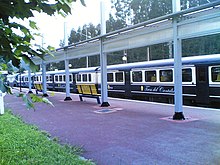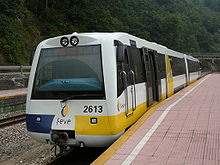Renfe Feve
 | |
 R4 line train atVillasana de Mena | |
 Regional and commuter services | |
| Predecessor | Ferrocarriles Españoles de Vía Estrecha (FEVE) |
|---|---|
| Formation | 6 July 1926(as EFE) 23 September 1965(as FEVE) 1 January 2013(merged into Renfe, as Renfe Feve) |
| Type | State-owned company |
| Purpose | Railway operatator |
| Location | |
| Services | rail |
| Owner | Renfe Operadora |
| Website | renfe |
| Renfe Feve | |
|---|---|
 | |
| Technical | |
| Track gauge | 1,000 mm(3 ft3+3⁄8in)metre gauge |
| Electrification | (?) |

Renfe Cercanías AM,[1]formerly known asRenfe Feve,is a division of state-owned SpanishrailwaycompanyRenfe Operadora.It operates most of Spain's 1,250 km (777 mi) ofmetre-gauge railway.This division of Renfe was previously a stand-alone company namedFEVE(Ferrocarriles de Vía Estrecha,Spanishfor "Narrow-Gauge Railways).[2]On 31 December 2012, the Spanish government simplified the organization of state-owned railway companies by merging FEVE into Renfe andAdif.[3]The rolling stock and the brand FEVE were transferred to Renfe (renamed "Renfe Feve" ), while the infrastructure was transferred to Adif.
History
[edit]
FEVEwas created in 1965, as a successor to the government-run organisation EFE (Explotación de Ferrocarriles por el Estado), which was created by theMiguel Primo de Riveraadministration in 1926 to take over failed private railways. Following the creation ofRENFEin 1941, to which the ownership of all Spanish broad-gauge railways were transferred to, EFE had in practice become the operator of a collection of exclusively narrow-gauge lines. The present status of FEVE, as a government-owned commercial company, dates from 1965.
The new company continued to absorb independent railway lines (1,435 mmor4 ft8+1⁄2instandard gauge,[4]1,067 mmor3 ft 6 in,[5]1,000 mmor3 ft3+3⁄8in,914 mmor3 ft&750 mmor2 ft5+1⁄2in), where the existing concession holders had been unable to be profitable. Most wereconvertedto1,000 mm(3 ft3+3⁄8in)metre gauge(if not already built in that gauge). However, from 1978 onwards, with the introduction of regionaldevolutionunder the new Spanishconstitution,FEVE also began transferring responsibility for a number of its operations to the new regional governments. This happened inCatalonia(FGC) in 1979, in a portion of theBasque(Euskotren) network in 1982, in theValencian Community(FGV) in 1986, and with theMajorcanRailways (SFM) in 1994. That did not however occur in theRegion of Murcia,where the narrow-gauge railway network remained under FEVE control. The above-mentioned EFE (Explotación de Ferrocarriles por el Estado) also operated theCarabanchel – Chamartín de la Rosa suburbanorailway in the city ofMadrid.That railway became part of theMadrid Metrowhen control of that line was transferred to theCommunity of Madridin the early-1980s, later integrated as the present-dayLine 10.
On 31 December 2012, the company disappeared due to the merger of the narrow gauge network FEVE and the broad gauge network RENFE. The infrastructure was transferred toAdifand the rolling stock was transferred toRenfe Operadora.The operation of the narrow gauge network continued under the same conditions after the reorganization.[3]
FEVE network
[edit]The great majority of the narrow-gauge lines that were operated by FEVE before it disappeared were located along or near Spain'sAtlantic OceanandBay of Biscaycoastline, which stretches fromGaliciain the northwest, throughAsturiasandCantabriato the Basque Country (with a branch extending intoCastile and León). Together they formed a large and strategically important system, which was why – unlike the other, more isolated regional railways – they have been retained under the integrated management of FEVE.
FEVE operated 1,192 km (741 mi)[6]of track, of which 316 km (196 mi) wereelectrified.


Transcantábricoline
[edit]An exclusive tourist service operated by FEVE is a 650 km (400 mi)[7]long line, theTranscantábrico,which runs along the entire length of Spain's north coast, and has connected the cities ofSan Sebastián,Bilbao,Santander,OviedoandFerroltoLeonsince 1982. Operated as a holiday service, the carriages of the train are furnished with bedrooms, lounges and restaurants and voyages typically last eight days and seven nights.
FEVE also operated "normal" regional (express and stopping) services (in sections) from Ferrol to Hendaye (some sections operated now by regional operators). One of the longest regular (non-tourist) FEVE service operated between Leon and Bilbao (a journey of some 7 hours).
Commuter services
[edit]FEVE also operated a range ofcercaníasor commuter services. The main commuter area isCercanías Asturias,where the dense five-line FEVE network was totally integrated with the RENFE lines and works effectively as a regional metro system.
The Bilbao area has a line running fromBilbao's Concordia stationto the large town ofBalmaseda,calling at local villages and settlements on its way throughBiscay,as well as the main towns of Basurto, Sodupe,Aranguren,andZalla.
Two commuter lines begin atSantander railway stationand terminate atLiérganesandCabezón de la Sal.
In southern Spain, Renfe Feve operates the historicCartagena-Los Nietos Line.
Goods operations
[edit]


FEVE's rails transported approximately 460 million tonnes[dubious–discuss]of goods each year, accounting for a large part of the company's business. The products one may expect to see on board their goods trains includeiron,steelandcoal,fueling much of the country's industry.
Companies operating former FEVE services
[edit]- EuskotrenandMetro Bilbao- in theBasque Country(there is a connecting line between the FEVE and EuskoTren networks in Bilbao[8])
- FGC- aroundBarcelona
- FGV- in theValencian Community
- SFM- on the island ofMajorca
- Metro de Madrid- in the city ofMadrid.
See also
[edit]References
[edit]- ^"Cercanías AM".Renfe(in Spanish).Retrieved20 October2023.
- ^"Decreto-ley 11/1965, de 23 de septiembre, por el que se reorganiza el Organismo autónomo «Explotación de Ferrocarriles por el Estado» que se denominará «Ferrocarriles de Vía Estrecha» (FEVE)"(PDF).Boletín Oficial del Estado(in Spanish) (230). Agencia Estatal Boletín Oficial del Estado: 13102. 25 September 1965.ISSN0212-033X.
- ^ab"Deja de existir FEVE, cuyo patrimonio de bienes y servicios se repartirá entre Renfe y Adif".RTVE(in Spanish). 31 December 2012.Retrieved31 December2012.
- ^Ferropedia - Compañía del Ferrocarril de Langreo en Asturias
- ^Tranvía de Cartagena a La Unión
- ^Renfe FEV website
- ^greenspainextract: "The remaining 650 km to the Atlantic coast are on the network of the FEVE" (Op the Google Map (See[1]) the distance is calculated at 641 km, estimated margin of error 0,5%).
- ^OpenstreetmapFile:FEVE-EuskoTren connection in colour.png
External links
[edit]- RENFE FEVE website(Spanish)
- Transcantábrico website(English)
